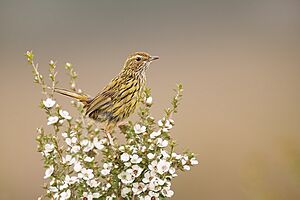Striated fieldwren facts for kids
Quick facts for kids Striated fieldwren |
|
|---|---|
 |
|
| in South West Tasmania | |
| Conservation status | |
| Scientific classification | |
| Genus: |
Calamanthus
|
| Species: |
fuliginosus
|
| Subspecies | |
|
|
The striated fieldwren (scientific name: Calamanthus fuliginosus) is a small bird that lives only in Australia. It belongs to a bird family called Acanthizidae.
Contents
What Does the Striated Fieldwren Look Like?
The striated fieldwren is a small bird, about 140 millimeters (or 5.5 inches) long. It has light brown and olive colors on its body. Its stomach is white, and it has black stripes all over.
Special Features of Its Feathers
The bird's tail points upwards and is whitish. It also has black and brown stripes. The front of the bird is a light yellowish-brown color. It has dark gray and brown stripes there.
Its wings are brown and gray with darker, bolder stripes. But the feathers it uses for flying do not have stripes. Instead, they have thin, light gray edges. You can also spot a whitish line above its eye.
How to Spot a Striated Fieldwren
Striated fieldwrens can be hard to see. They usually look for food quietly in thick vegetation or on the ground. If you get too close, the bird will lift its tail. It might even move its tail from side to side. It will keep singing until it feels trapped. Then, it will fly away to a new spot.
Sounds and Songs of the Striated Fieldwren
It is easier to spot the striated fieldwren in springtime. This is when the male birds perch on plants and sing. Striated fieldwrens have a special song. It sounds strong and whirring.
When You Can Hear Their Songs
Their song is often heard from the tops of bushes. This can sometimes make people confuse them with other bird species. You can hear their familiar sound a lot in winter and spring. There is only a short time when their "sweet little strain" cannot be heard.
The songs of the striated fieldwren can change throughout the year. However, their chirping sound is heard less often outside of their breeding season. The striated fieldwren has a loud song. Some people describe it as sounding like whit whit chee whit whit pee chew.
Where Striated Fieldwrens Live
Striated fieldwrens are easier to see in springtime. This is true even though they can hide well in plants. This small olive-brown bird lives in places with thick heath, grassland, and salt marsh.
Common Locations in Australia
You can often find striated fieldwrens in coastal areas. These include South Australia, Victoria, New South Wales, and Tasmania. Sadly, the striated fieldwren is now considered a vulnerable species. This is because their homes have been lost. Land has been cleared and their habitats have been damaged.
Because of these changes, you often find them in national parks and reserves. They have been known to move around locally in New South Wales. Striated fieldwrens can be found alone, in pairs, or in family groups. They usually stay in the low bushes and shrubs of these areas.
Diet and Reproduction
The places where these birds live are also important for their breeding. Striated fieldwrens build their nests in pairs. They make a compact, round nest. It is built from coarse grass, seaweed, moss, and leaves from the area.
Nesting Habits
Their nests are hidden under thick bushes and grass. These areas are sometimes at risk of flooding or being trampled by farm animals. Where they live also depends a lot on what they eat.
What Striated Fieldwrens Eat
They are known to eat and forage for arthropods and seeds found in their area. Fieldwrens eat specific arthropods. These include beetles from families like Chrysomelidae, Curculionidae, and Dytiscidae.


